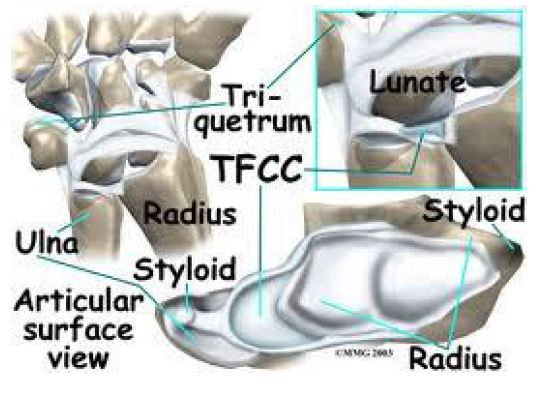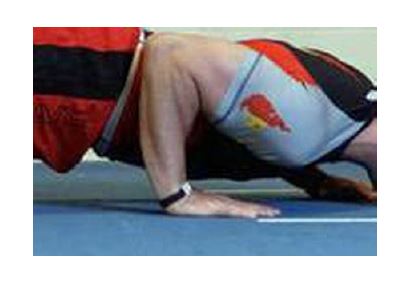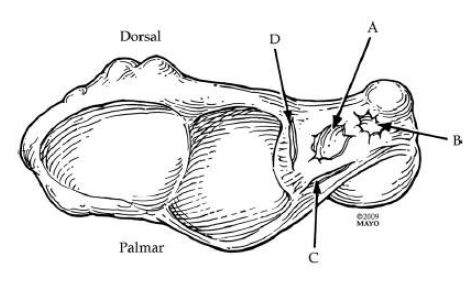TFCC Tear/Ulnar Sided Wrist pain
What is a TFCC tear
The triangular fibrocartilaginous complex (TFCC) is a structure on the small finger side of the wrist. It is the main stabilizer to the wrist in rotation (pronation and supination). It also cushions and supports the small bones of the wrist, especially when gripping. An injury to the TFCC can cause chronic wrist pain. Luckily, treatment does not depend on the chronicity of the injury. Those with long-standing pain can often get better.
What are the symptoms of a TFCC tear
TFCC tears cause pain on the “ulnar side” of the wrist. It is the side opposite the thumb, or directly on top of the ulna bone. The ulna bone is the small bone in the forearm. The radius rotates around the ulna when someone pronates (palm down) or supinates (palm up). Most commonly there will be a pain at end range supination, with grip, and when bearing weight on the affected arm. There also can be numbness going toward the small finger. Often there is a weak grip.
How does one get a TFCC tear
To understand the TFCC injury, one first must understand the types of TFCC tears. There are traumatic tears (Type I) and degenerative tears (Type II). A traumatic tear will often come from a fall on an outstretched hand, or a forced twisting injury (a drill catching, baseball, hockey). A traumatic tear usually occurs through the outside ligamentous portion of the TFCC. If someone has an acute injury with significant pain, they should be seen as soon as possible as this may be able to be treated without surgery.
Degenerative or ‘wear and tear’ injuries to the TFCC are more common. They can be associated with generalized wrist arthritis, an ulna bone that is too long, or old distal radius fractures. The causes of these are thought to be due to pressure from the ulna pushing up on the articular disc of the TFCC and causing injury.
How do we make a Diagnosis of a TFCC tear
A careful history of the injury and a thorough physical examination are important for a diagnosis. X-rays of both wrists are taken to check for any bony abnormalities. MRI is very helpful in diagnosis. Unfortunately, MRI can miss the diagnosis, especially in those that have had a tear for a long time. MRI is helpful in ruling out other conditions of the wrist that can mimic a TFCC tear. Anyone undergoing wrist arthroscopy for a diagnosis of TFCC tear should have an MRI.
How do we treat a TFCC tear
Treatment depends on the type of tear.
- Traumatic tears:
- Acute: After an injury, if a TFCC tear is suspected, an MRI is obtained to confirm the diagnosis and ensure no other injuries. If the injury is within 1-2 weeks, we can usually get the injury to heal without surgery. A long arm cast is used for a month. This will prevent rotation. A brace that limits rotation to a small arc is used for another month. Depending on the sport and symptom level, a patient can return to activities at 2-3 months with the wrist
- Chronic: This is most often the case. A ‘wrist sprain’ that just hasn’t gotten Of course, the patient did not know they had a significant injury. They may have been to the ER and had normal x-rays. They may have worn a splint for a couple of weeks. These patients are treated with wrist arthroscopy and arthroscopic repair of the TFCC. These patients will also have to be prevented from rotating after surgery like the non-operative patients. Surgical patients can’t return to sport for 3 months.
- Degenerative
Patients with degenerative tears are treated according to other pathology that may be present. Most patients will have had pain for some time. Most will opt for surgical intervention. The difference in surgery is that the TFCC cannot be repaired. The portion that is injured in a degenerative tear is the center or avascular zone of the TFCC. This is treated much like a meniscal tear in the knee. We will use arthroscopic means to shave down the torn edges and decrease the mechanical catching that causes pain. Sometimes we can shave the tip of the ulna bone off if it is in the way. If the ulna bone is quite long, we may need to shorten the bone (rare).
Outcome of TFCC injuries
The outcome of nonsurgical acute casting of TFCC tears is excellent. Unfortunately, it seems that the only patients that are seen early are high-level athletes. Surgical treatment for traumatic tears is generally better than degenerative tears. As in most, younger patients do better than older patients. The good news is that it doesn’t matter how long a TFCC has been injured. Surgery has been performed on patients who have had tears for up to 8 years with excellent results.



